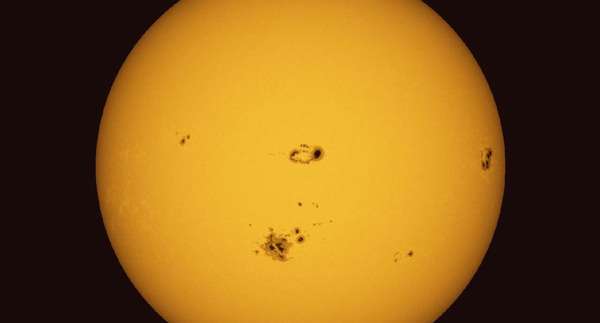[/caption]
For solar enthusiasts, we’re all quite aware of sunspots and their implications. Able to disrupt power grids, shut down satellite communications and pose hazards to astronauts, these “cool” customers are revealing themselves ahead of their surface appearance. Thanks to the Michelson Doppler Imager aboard NASA’s Solar and Heliospheric Observatory satellite, known as SOHO, researchers were able to take 15 years of “sound” data from our nearest star… and develop a new technique for detecting sunspots before they emerge.
By combining information with NASA’s Solar Dynamics Observatory satellite, which carries the Helioseismic and Magnetic Imager, scientists have discovered a new method for detecting sunspots as deep as 65,000 kilometers below the solar surface. The areas of intense magnetic fields produce acoustic waves from the turbulence of plasma and gases. Near the surface, a convection cell echoes the information which travels back to the solar interior – only to be refracted again. By comparing their findings to seismic waves studied here on Earth, researchers measure the waves between points to predict anomalies.
Detection of Emerging Sunspot Regions – 18 August 2011: Movie showing the detected travel-time perturbations before the emergence of active region 10488 in the photosphere. The first 10 seconds of the movie show intensity observations of the Sun. The intensity later fades out and the photospheric magnetic field is shown. In the next 20 seconds, we zoom in to a region where a sunspot group would emerge. The upper layer shows magnetic field observations at the surface and the lower layer shows simultaneous travel-time perturbations, detected at a depth of about 60,000 km. After the emergence, intensity observations show the full development of this active region, until it rotates out of view on the west solar limb. (movie made by Thomas Hartlep) Courtesy of the Helioseismic and Magnetic Imager.
“We know enough about the structure of the Sun that we can predict the travel path and travel time of an acoustic wave as it propagates through the interior of the Sun,” said Junwei Zhao, a senior research scientist at Stanford’s Hansen Experimental Physics Lab. “Travel times get perturbed if there are magnetic fields located along the wave’s travel path.”
By comparing and measuring millions of pairs and points, researchers are able to pinpoint areas where sunspots are likely to happen. What they have discovered is larger spots rise to the surface faster than smaller ones… a prediction which can be made in approximately 24 hours. For less ominous appearances, lead times increase to up to two days.
“Researchers have suspected for a long time that sunspot regions are generated in the deep solar interior, but until now the emergence of these regions through the convection zone to the surface had gone undetected,” Ilonidis said. “We have now successfully detected them four times and tracked them moving upward at speeds between 1,000 and 2,000 kilometers per hour.”
The ultimate goal is to improve space weather forecasting. If events can be predicted three days prior, advance notice can be given and proper precautions taken.
Original Story Source: Stanford University News.


Yo Tammy, at the image caption, the parenthetical phrase “such as these” should be offset with a pair of commas in order to avoid ambiguity.